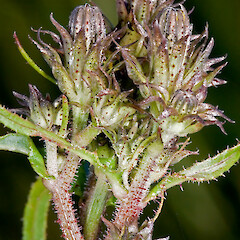Picris burbidgeae
Synonyms
None. In the most recent New Zealand flora treatment all indigenous Picris have been referred to Picris hieracioides L. as species collected here once as a naturalised weed, and to which none of our indigenous species are closely related.
Family
Asteraceae
Flora category
Vascular – Native
Endemic taxon
No
Endemic genus
No
Endemic family
No
Structural class
Herbs - Dicotyledonous composites
NVS code
The National Vegetation Survey (NVS) Databank is a physical archive and electronic databank containing records of over 94,000 vegetation survey plots - including data from over 19,000 permanent plots. NVS maintains a standard set of species code abbreviations that correspond to standard scientific plant names from the Ngä Tipu o Aotearoa - New Zealand Plants database.
PICBUR
Chromosome number
2n = 10
Current conservation status
The conservation status of all known New Zealand vascular plant taxa at the rank of species and below were reassessed in 2017 using the New Zealand Threat Classification System (NZTCS) – more information about this can be found on the NZTCS website. This report includes a statistical summary and brief notes on changes since 2012 and replaces all previous NZTCS lists for vascular plants.
Please note, threat classifications are often suggested by authors when publications fall between NZTCS assessment periods – an interim threat classification status has not been assessed by the NZTCS panel.
- Conservation status of New Zealand indigenous vascular plants, 2017 . 2018. Peter J. de Lange, Jeremy R. Rolfe, John W. Barkla, Shannel P. Courtney, Paul D. Champion, Leon R. Perrie, Sarah M. Beadel, Kerry A. Ford, Ilse Breitwieser, Ines Schönberger, Rowan Hindmarsh-Walls, Peter B. Heenan and Kate Ladley. Department of Conservation. Source: NZTCS and licensed by DOC for reuse under the Creative Commons Attribution 4.0 International licence.
2017 | Threatened – Nationally Vulnerable | Qualifiers: EF, PD, SO, Sp
Previous conservation statuses
2012 | Threatened – Nationally Endangered | Qualifiers: EF, PD, SO, Sp
2009 | Threatened – Nationally Endangered | Qualifiers: EF, PD, SO, Sp
2004 | Threatened – Nationally Endangered
Distribution
Indigenous. New Zealand: Manawatāwhi / Three Kings Islands, North Island (Te Paki to the Huntly Basin, near Waihi and Rotorua Lakes area, as well as most of the Hauraki Gulf islands), Rēkohu / Wharekauri / Chatham Island. Also eastern Australia, Norfolk Island, and the main island of Hawaii
Habitat
Primarily on offshore islands or in coastal or lowland situations. Often on talus slopes. This species requires open ground and will not tolerate heavy shade. It has been collected from gravelled margins of roadsides and in gravel pits.
Detailed description
Annual to perennial herb 0.5–1.2–(2) m tall. Stem basally woody, dark green to purple-green, branched from upper ½–⅓. Indumentum of 2-hooked, bristly hairs, copious. Leaves yellow-green. Rosette leaves shortly petiolate, lamina 100–200 × 10–25 mm, narrowly lanceolate to ovate, entire or dentate; stem leaves lanceolate to narrowly lanceolate, entire or dentate, becoming smaller toward plant apex. Lower stem leaves 100–200 × 10–25 mm. Upper stem leaves 20–40 × 0.3–0.5 mm. Terminal leaves bract or thread-like. Inflorescences in corymbose panicles. Capitula numerous, 9–12 mm long, 5–6 mm diameter, with 30–45 sulphur yellow flowers. Involucrum of 28–40 bracts in 3–4 irregular outer and 2 inner rows, length of bracts increasing from outer to inner rows. Bracts with a single line of 2-hooked anchor or bifid hairs along midrib on outer surface. Achenes narrowly fusiform 4–5 mm long, 0.8–1.1 mm diam, tapering into short cuspis. Achene ribs 20–35. Pappus 5–8 mm long, pappus rays 50–80.
Similar taxa
The stem and leaf indumentum of oxtongue (Helminthotheca echioides (L.) Holub) has 2-, 3-, 4- or 5-hooked anchor hairs and the hairs of the leaves arise from a conspicuous swollen base. The involucral bracts of the flowers are in two rows, with the five outer involucral bracts ovate to cordate, and the apex of the inner bracts feather-like. Unlike our indigenous oxtongues (Picris spp. ) the achenes of the introduced oxtongue (H. echioides) are heteromorphic: the outer achenes, are larger, white, and pilose hairy; the inner shorter, dark-brown and glabrous. In our indigenous oxtongues (Picris spp.) the achenes are never heteromorphic.
Flowering
(July)–October–January–(May)
Flower colours
Yellow
Fruiting
(August)–October–(June)
Propagation technique
Easy from fresh seed which usually germinates within one to two months. A somewhat unusual plant that is unlikely to prove popular in cultivation, and it can become invasive in some situations.
Threats
Habitat loss through coastal development, succession, displacement by weed invasion, it is also prone top accidental eradication because of its weedy appearance.
Where To Buy
Plants can be seen at the Auckland Regional Council Botanic Gardens, at Manurewa, and at Auckland Zoo.
Cultural Use/Importance
Picris burbidgeae differs from P. angustifolia DC chiefly by details of its involucrum. In this species they are in 2–4 rows. The outer bracts are longer than ⅔ of the length of the innermost bracts, often almost as long as the inner bracts. The outer bracts are usually recurved and become distinctly squarrose and are either not as wide or wider than the inner bracts. The achenes are smaller (5–8 mm) and also the cuspis (0.3–0.9 mm). The cuspis is ⅙ – ⅟14 the total achene length.
Attribution
Fact Sheet Prepared by P.J. de Lange (1 November 2009). Description based on Holzapfel & Lack (1993) and fresh specimens. Description subsequently published in de Lange et al (2010).
References and further reading
de Lange PJ, Heenan PB, Norton DA, Rolfe JR, Sawyer JWD. 2010. Threatened Plants of New Zealand. Canterbury University Press, Christchurch. 471 p.
Holzapfel S, Lack HW. 1993. New species of Picris (Asteraceae, Lactuceae) from Australia. Willdenowia 23: 181–191.
NZPCN Fact Sheet citation
Please cite as: de Lange, P.J. (Year at time of access): Picris burbidgeae Fact Sheet (content continuously updated). New Zealand Plant Conservation Network. https://www.nzpcn.org.nz/flora/species/picris-burbidgeae/ (Date website was queried)























